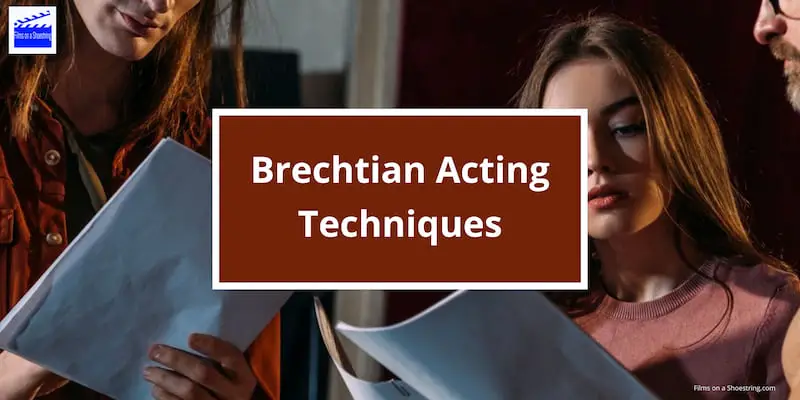Discover what Brechtian Acting Techniques are and why they are still relevant to stage acting today.
Brechtian acting techniques, named after the renowned German playwright Bertolt Brecht, have had a significant impact on modern theatre.
These techniques aim to create a sense of critical distance between the audience and the performance, encouraging them to think critically about social and political issues.
By breaking the illusion of realism and incorporating elements such as direct address, gestus, and alienation effects, Brechtian acting techniques challenge the traditional notions of theatre and invite active engagement from the audience.
Purpose and Principles of Brechtian Acting
At the core of Brechtian acting techniques lies the desire to provoke social change and create a more politically conscious audience.
Brecht believed that theatre should not merely entertain, but also educate and engage the audience intellectually. Some key principles of Brechtian acting include:
- Verfremdungseffekt (Alienation Effect): This technique aims to distance the audience emotionally from the characters and the story, preventing them from becoming fully absorbed in the narrative. By highlighting the artificiality of the performance, the audience is encouraged to critically reflect on the themes and messages portrayed on stage.
- Epic Theatre: Brechtian acting emphasizes the episodic nature of storytelling, using fragmented scenes and non-linear narratives to highlight social and political issues. The audience is encouraged to analyze the events and recognize the underlying structures and systems at play.
- Gestus: Brecht placed great importance on the physical gestures and mannerisms of characters, which he referred to as gestus. These gestures were used to convey the social and political relationships between characters, emphasizing the broader societal context in which the story unfolds.
- Direct Address: Actors in Brechtian theatre often break the fourth wall and directly address the audience. This technique disrupts the illusion of the performance and serves to remind the audience of their role as active participants in the theatrical experience.
By employing these techniques, Brechtian acting creates a space for critical reflection and promotes a more politically engaged audience. It challenges traditional theatrical conventions and invites viewers to question the status quo through a thoughtful and intellectually stimulating theatrical experience.
Verfremdungseffekt (Alienation Effect)
The Verfremdungseffekt, also known as the Alienation Effect, is a theatrical technique developed by the renowned German playwright and director, Bertolt Brecht.
This technique aims to create a sense of distance and detachment between the audience and the performance, encouraging critical thinking and analysis.
By breaking the illusion of reality, the Verfremdungseffekt disrupts the traditional, emotional connection between the audience and the characters, and prompts them to question societal norms and power structures.
To implement the Verfremdungseffekt in acting, actors can use various techniques such as:
1. Gestus: This technique involves using exaggerated and stylized physical movements to convey a character’s social and political attitudes. It encourages actors to portray characters in a way that highlights their ideologies and conflicts.
2. Breaking the Fourth Wall: Actors can directly address the audience, breaking the illusion of a fictional world and making the audience aware that they are watching a performance. This helps to create a critical distance and fosters engagement with the underlying social and political messages.
3. Use of Signs and Props: Actors can use signs, banners, or props that explicitly convey the intended message or theme of the performance. By making these symbols visible and recognizable, the Verfremdungseffekt aims to invoke thought and reflection in the audience.
The Verfremdungseffekt is a powerful technique that challenges conventional theatrical norms and encourages audiences to actively engage with the performance. It remains a fundamental tool in Brechtian acting and continues to influence contemporary theater practices.
Gestus (Gestural Language)
Understanding Brecht’s Theory of Gestus
In Brechtian acting, Gestus refers to the physical gestures and expressions that actors use to convey social and political messages.
Brecht believed that these gestures should be exaggerated and deliberate, allowing the audience to critically examine the characters and the society they represent.
By using Gestus, actors can break the fourth wall and engage the audience in a dialogue about the issues portrayed in the play.
Practicing Gestural Language in Brechtian Acting
To practice Gestus in Brechtian acting, actors should focus on the following techniques:
- Exaggerating facial expressions and body movements to communicate the intended message effectively
- Using bold and deliberate gestures to highlight the social and political themes in the play
- Developing a consistent use of gestures that reflect the character’s ideology and motivations
- Utilizing contradictory gestures to challenge the audience’s preconceptions and provoke critical thinking
- Collaborating with the director and fellow actors to ensure that the Gestus aligns with the overall vision of the production
By mastering the art of Gestus, actors can effectively communicate Brecht’s intended messages and create thought-provoking performances that challenge societal norms.
Epic Theatre and Epic Acting
Examining the Characteristics of Epic Theatre
Epic Theatre, a groundbreaking form of theatre developed by the German playwright and theorist Bertolt Brecht, aimed to engage audiences intellectually and politically. It challenged the traditional notions of theatre by breaking the fourth wall and encouraging critical thinking.
Some key characteristics of Epic Theatre include:
- Alienation Effect (Verfremdungseffekt): Breaking the illusion and reminding the audience that they are watching a performance.
- Non-linear narrative structure: Jumping between scenes and events to create a holistic and objective perspective.
- Use of songs and music: Incorporating songs and music to comment on the action and provide emotional distance.
Key Elements of Epic Acting in Brechtian Style
Brechtian acting, also known as Epic Acting, is characterized by a specific set of techniques that align with the principles of Epic Theatre. Some key elements of Epic Acting include:
- Gestus: Physical gestures and mannerisms used to convey meaning and social attitudes.
- Verbal Gestus: Use of voice and language to create a distanced effect and highlight the social and political context.
- Breaking the Fourth Wall: Directly addressing the audience and acknowledging the theatricality of the performance.
- Emotional detachment: Actors maintain a degree of emotional distance, preventing the audience from fully immersing themselves in the narrative.
These techniques and elements of Brechtian acting contribute to the unique style of Epic Theatre, challenging conventions and creating a thought-provoking theatrical experience.
Breaking the Fourth Wall
The Significance of Breaking the Fourth Wall in Brechtian Theatre
In Brechtian theatre, breaking the fourth wall is a technique that involves actors acknowledging the audience and directly addressing them. This technique serves several purposes, including:
- Creating a sense of distance and alienation, reminding the audience that they are watching a performance
- Encouraging critical thinking and engagement with the themes and messages of the play
- Challenging traditional theatrical conventions and highlighting the artifice of the medium
Techniques for Breaking the Fourth Wall in Acting
There are various techniques that actors can employ to effectively break the fourth wall in their performances. These include:
- Directly addressing the audience through direct eye contact and speaking directly to them
- Inviting audience participation, such as asking for volunteers or engaging in interactive moments
- Incorporating improvised moments that react to the audience’s reactions
- Using humor and wit to engage and entertain the audience while breaking the fourth wall
By using these techniques, actors can create a unique and engaging experience for the audience, breaking down the traditional boundaries between performers and spectators in Brechtian theatre.
Brecht Exercises
Hear an acting coach walk explain the Brechtian acting exercises.
“Music and song in Brechtian theatre isn’t for entertainment sake. It’s used as a narration tool.”
Key topics in the video cover:
- Epic Theatre and Verfremdungseffekt
- Objective rationalization of the audience; Making the familiar strange; Techniques used in rehearsal; Music and song as narration tools; Use of placards for social commentary; Multi-role and costume to create distance; Gestus and archetypes as stage pictures
- Politics and its Influence on Brecht
- Germany’s post-World War I situation; Impact of the Wall Street crash; Poverty and inequality witnessed by Brecht; Rise of National Socialism and the Nazi Party
- Brecht’s Impact and Ban
- Banned writings and theatre; Relocation to other European countries; Development of epic theatre in the USA
- Marxism and Capitalism
- Capitalism as a broken system; Workers’ poverty and inequality
- Bertolt Brecht
- Playwright, activist, and political writer; Marxist beliefs
The dialogue also discusses the actor’s perspective on playing the character John, his actions in a shop, and his shift towards a more objective viewpoint focused on social themes and commentary.
Brechtian Acting Exercises & Games
Effective Exercises and Games to Develop Brechtian Acting Skills
To fully embrace the Brechtian acting style, actors can engage in various exercises and games that help them develop the necessary skills. These activities focus on encouraging performers to break the illusion of reality and engage the audience intellectually. Some effective exercises and games include:
- Alienation Exercise: In this exercise, actors are encouraged to break the fourth wall and directly address the audience, creating a sense of distance and making the audience aware of the performance.
- Historification Game: The historification game involves actors using historical characters or situations to explore social and political themes. This allows the actors to detach themselves from the character and view the performance objectively.
Examples and Instructions for Brechtian Acting Exercises
For the alienation exercise, actors can:
- Choose a monologue or scene from a play and perform it while actively acknowledging the presence of the audience. This can be done by maintaining eye contact with the audience, speaking directly to them, or even involving them in the performance.
- Practice emotional detachment by intentionally distancing themselves from the character’s emotions. Instead of getting emotionally involved, the actor should focus on delivering the lines and conveying the message to the audience.
The historification game can be played by:
- Selecting a historical event or character and researching its relevance to the themes explored in the play.
- Incorporating the historical elements into the performance, such as costumes, props, or dialogue. This helps create a critical distance between the actor and the character, allowing for a more objective portrayal.
By regularly practicing these exercises and games, actors can develop their Brechtian acting skills and create performances that challenge the audience’s perspective and stimulate critical thinking.
Applying Brechtian Techniques in Contemporary Theatre
Exploring the Influence of Brechtian Acting on Modern Productions
Brechtian acting techniques have had a significant impact on contemporary theatre, influencing how performances are approached and executed. Here are some ways in which Brechtian techniques are applied in modern productions:
- Verfremdungseffekt: The use of alienation techniques to keep the audience engaged and critical of the performance.
- Epic Theatre: The emphasis on storytelling and addressing social and political issues.
- Breaking the Fourth Wall: Directly addressing the audience and acknowledging the theatrical nature of the performance.
These techniques help create a distinctive theatrical experience that challenges the audience’s traditional perceptions and encourages them to reflect on the themes and messages of the play.
Brechtian Acting Techniques in Modern Theatre
Brechtian acting techniques are just one of the acting techniques to build a believable character and performance used by actors today. Whether it’s Stanislavski, Meisner, or any of the other experienced acting teachers, many of whom have published books about acting craft, each brings a different set of theories to the stage performer.
Brechtian acting techniques offer actors a unique and thought-provoking approach to their craft. By breaking the fourth wall, incorporating alienation techniques, and focusing on social and political themes, actors can create performances that challenge and engage their audiences. Key takeaways and tips for actors interested in the Brechtian style include:
- Embrace the idea of making the familiar strange
- Develop a strong understanding of the social and political context of your performance
- Experiment with different alienation techniques, such as using direct address or incorporating music and song
- Practice embodying the “non-identification” aspect of Brechtian acting
- Continually question and analyze your performance choices to ensure they align with Brecht’s principles
By incorporating these techniques and principles into their work, actors can create performances that resonate with audiences and inspire critical thinking.
More for Actors
- Casting Agents UK: What You Need To Know
- What Makes a Good Actor?
- How to Act Drunk for Actors on Stage and Screen
- Brechtian Acting Techniques & Exercises
- Film Set Etiquette: Professional Behaviour on Set
- What Do Actors Do If They Don’t Make It?
- Acting Terminology
- Self Tape Audition Mistakes to Avoid
- Meisner Acting Technique
- Can You be an Actor and a Filmmaker?
- How Do Actors Cry?
- How Do Actors Remember Their Lines?
- Can Actors Drink Alcohol on TV?
- Allen & Abel Acting Agency
- Do actors have personalities?
- Will Actors be Replaced by Robots, CGI or AI?
- Are Actors Smart?
- How Does An Actor Get A Role?
- Can Actors Have Tattoos?
- Casting Type: What Actor Type Are You?






















